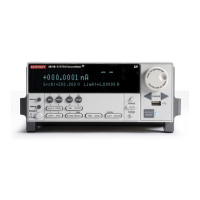12-36 Return to Section Topics 2600S-901-01 Rev. C / January 2008
Section 12: Instrument Control Library Series 2600 System SourceMeter® Instruments Reference Manual
exit function
This function is used to terminate a script that is presently running.
Function Stops execution of a script.
Usage exit()
Remarks Terminates script execution when called from a script that is being executed.
This command will not wait for overlapped commands to complete before terminating script
execution. If overlapped commands are required to finish, use the
waitcomplete function prior to calling exit.
Also see “System behavior, Abort” in Section 9.
format attributes
The format attributes are used to configure the output formats used by the printnumber and
printbuffer functions. These attributes are used to set the data format (ASCII or binary), ASCII
precision (number of digits) and binary byte order (normal or swapped).
errorqueue.next
Function Reads an entry from the error/event queue.
Usage errorcode, message, severity, node = errorqueue.next()
errorcode Returns the error code number for the entry.
message Returns the message that describes the entry.
severity Returns the severity level (0, 10, 20, 30 or 40).
node Returns the node number where the error
originated.
Remarks • Entries are stored in a first-in, first-out (FIFO) queue. This function reads the oldest entry
and removes it from the queue.
• Error codes and messages are listed in Table B-2 in Appendix B.
• If there are no entries in the queue, code 0, “Queue Is Empty” is returned.
• Returned severity levels include the following:
0 Informational – Indicates no error: “Queue is Empty”.
10 Informational – Indicates an event or a minor error. Examples: “Reading Available”
and “Reading Overflow”.
20Recoverable – Indicates possible invalid user input. Operation will continue but
action should be taken to correct the error. Examples: “Exponent Too Large” and
“Numeric Data Not Allowed”.
30 Serious – Indicates a serious error and may require technical assistance. Example:
“Saved calibration constants corrupted”.
30 Fatal – Indicates that the Series 2600 is non-operational and will require service.
Contact information for service is provided in
Section 1. Examples: “Bad SMU
AFPGA image size”, “SMU is unresponsive” and “Communication Timeout with
DFPGA”.
• In an expanded system, each TSP-Link enabled instrument is assigned a node number.
node returns the node number where the error originated.
Details See Appendix B (error and status messages) and Appendix D (status model).
Also see errorqueue.clear, errorqueue.count
Example Reads the oldest entry in the error/event queue:
errorcode, message = errorqueue.next()
print(errorcode, message)
Output: 0.000000e+00 Queue Is Empty
The above output indicates that the queue is empty.
exit
format.asciiprecision

